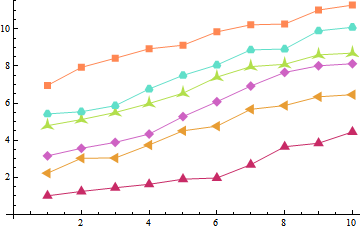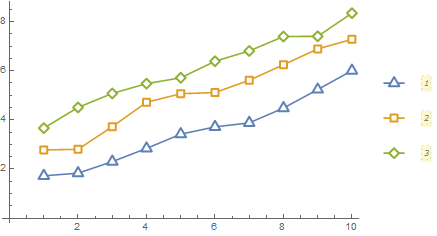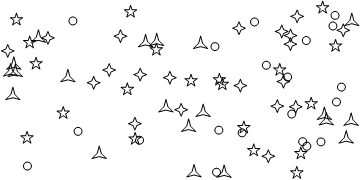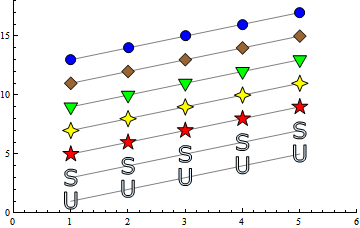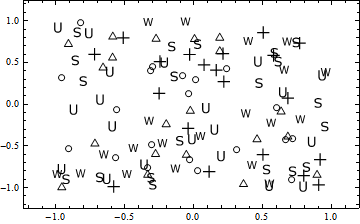Based on Oleksandr's excellent design idea here is my re-implementation of his package which offers much richer set of shapes.
How to install the package
The most recent version of the package can be installed from GitHub by evaluating the following:
(* Load the package code *)
package =
Import["http://raw.github.com/AlexeyPopkov/PolygonPlotMarkers/master/PolygonPlotMarkers.m", "Text"];
(* Install the package (existing file will be overwritten!) *)
Export[FileNameJoin[{$UserBaseDirectory, "Applications",
"PolygonPlotMarkers.m"}], package, "Text"];
For manual installation copy the code from the bottom of this post and save as "PolygonPlotMarkers.m" in the directory SystemOpen[FileNameJoin[{$UserBaseDirectory, "Applications"}]].
Description of the package
- The basic usage syntax is
PolygonMarker[shape, size]whereshapeis a name of built-in shape or a list of 2D coordinates describing a non-selfintersecting polygon. Thesizecan be given as a number or inScaledorOffsetform.
PolygonMarker[All]andPolygonMarker[]return the list of names of built-in shapes.
PolygonMarker[shape, size]returnsPolygongraphics primitive which can be used inGraphics.
- With
Offsetsizespecification the plot marker has fixed size specified in printer's points independent of the size of the plot.
PolygonMarkers with identicalsizespecifications have equal areas (not counting the area taken by the edge of generatedPolygon).PolygonMarker[shape, size]returns shape with areasize2in the internal coordinate system ofGraphics.PolygonMarker[shape, Offset[size]]returns shape with areasize2square printer's points.
- The centroid of polygon returned by
PolygonMarker[shape, size]is always placed at{0, 0}in the internal coordinate system ofGraphics.
PolygonMarker[shape, size, positions]wherepositionsis a list of 2D coordinates evaluates toTranslate[PolygonMarker[shape, size], positions]. It represents a collection of multiple identical copies of the shape with centroids placed atpositions.
Basic examples of use
The complete list of built-in named shapes:
Needs["PolygonPlotMarkers`"]
allShapes = PolygonMarker[All]
Tooltip[Graphics[{FaceForm[Hue@Random[]],
EdgeForm[{Black, Thickness[0.003], JoinForm["Miter"]}], PolygonMarker[#, 1]},
ImageSize -> 30, PlotRange -> 1.5, PlotRangePadding -> 0,
ImagePadding -> 0], #] & /@ allShapes
{"TripleCross", "Y", "UpTriangle", "UpTriangleTruncated", "DownTriangle", "DownTriangleTruncated", "LeftTriangle", "LeftTriangleTruncated", "RightTriangle", "RightTriangleTruncated", "ThreePointedStar", "Cross", "DiagonalCross", "Diamond", "Square", "FourPointedStar", "DiagonalFourPointedStar", "FivefoldCross", "Pentagon", "FivePointedStar", "FivePointedStarThick", "SixfoldCross", "Hexagon", "SixPointedStar", "SixPointedStarSlim", "SevenfoldCross", "SevenPointedStar", "SevenPointedStarNeat", "SevenPointedStarSlim", "EightfoldCross", "Disk", "H", "I", "N", "Z", "S", "Sw", "Sl"}
When used in conjunction with such functions as ListPlot, ListLinePlot, ListLogPlot etc. it is highly recommended to include AlignmentPoint -> {0, 0} option for achieving exact positioning of markers on the plot (this option with default ImagePadding and ImageMargins doesn't affect Exporting to PDF, EPS or SVG but affects on-screen rendering and Exporting to raster formats):
(* full marker which picks up the PlotStyle automatically *)
fm[name_, size_: 7] :=
Graphics[{EdgeForm[], PolygonMarker[name, Offset[size]]}, AlignmentPoint -> {0, 0}];
SeedRandom[25] (* for reproducibility *)
ListPlot[
Table[Accumulate@RandomReal[1, 10] + i, {i, 6}],
PlotMarkers ->
fm /@ {"Triangle", "LeftTriangle", "Diamond", "ThreePointedStar", "UpTriangleTruncated",
"Square"},
Joined -> True, PlotStyle -> ColorData[54, "ColorList"]]
Automatic plot legends (Mathematica 10 or higher) often require larger value for LegendMarkerSize option in order to avoid cropping:
(* empty marker which picks up the PlotStyle automatically *)
em[name_, size_: 7] :=
Graphics[{Dynamic@
EdgeForm@Directive[CurrentValue["Color"], JoinForm["Round"], AbsoluteThickness[2],
Opacity[1]], FaceForm[White], PolygonMarker[name, Offset[size]]},
AlignmentPoint -> {0, 0}]
SeedRandom[2]
ListPlot[
Table[Accumulate@RandomReal[1, 10] + i, {i, 3}],
PlotMarkers -> em /@ {"Triangle", "Square", "Diamond"},
Joined -> True, PlotLegends -> PointLegend[Automatic, LegendMarkerSize -> {40, 25}]
]
Advanced usage
The third argument of PolygonMarker can be used to specify the coordinate(s) where the shape should be placed:
Graphics[{FaceForm[], EdgeForm[{Black, AbsoluteThickness[1], JoinForm["Miter"]}],
PolygonMarker["Circle", Offset[7], RandomReal[{-1, 1}, {20, 2}]],
PolygonMarker["ThreePointedStar", Offset[7], RandomReal[{-1, 1}, {20, 2}]],
PolygonMarker["FourPointedStar", Offset[7], RandomReal[{-1, 1}, {20, 2}]],
PolygonMarker["FivePointedStar", Offset[7], RandomReal[{-1, 1}, {20, 2}]]},
AspectRatio -> 1/2]
The package allows to use arbitrary polygon as a plot marker. Here is an auxiliary function which converts simple glyph into a set of points suitable for PolygonMarker:
pts[l_String] :=
First@Cases[
ImportString[
ExportString[Style[l, FontFamily -> "Verdana", FontSize -> 20],
"PDF"], "PDF"], c_FilledCurve :> c[[2, 1]], Infinity];
(This conversion is approximate. If precise conversion is needed one can apply one of the methods described in "How can I adaptively simplify a curved shape?")
An example of use:
ListPlot[ConstantArray[Range[5], 7] + Range[0, 12, 2],
PlotStyle -> Gray, Joined -> True, PlotMarkers -> {
Graphics[{FaceForm[LightBlue], EdgeForm[Black],
PolygonMarker[pts["U"], Scaled[0.05]]}, AlignmentPoint -> {0, 0}],
Graphics[{FaceForm[LightBlue], EdgeForm[Black],
PolygonMarker[pts["S"], Scaled[0.05]]}, AlignmentPoint -> {0, 0}],
Graphics[{FaceForm[Red], EdgeForm[Black],
PolygonMarker["FivePointedStar", Scaled[0.05]]}, AlignmentPoint -> {0, 0}],
Graphics[{FaceForm[Yellow], EdgeForm[Black],
PolygonMarker["FourPointedStar", Scaled[0.05]]}, AlignmentPoint -> {0, 0}],
Graphics[{FaceForm[Green], EdgeForm[Black],
PolygonMarker["DownTriangle", Scaled[0.05]]}, AlignmentPoint -> {0, 0}],
Graphics[{FaceForm[Brown], EdgeForm[Black],
PolygonMarker["DiagonalSquare", Scaled[0.05]]}, AlignmentPoint -> {0, 0}],
Graphics[{FaceForm[Blue], EdgeForm[Black],
Disk[{0, 0}, Scaled[0.05/Sqrt[π]]]}, AlignmentPoint -> {0, 0}]},
PlotRange -> {{0, 6}, {0, 18}}]
Here is an example of a plot where plotting symbols significantly overlap, I use here some of the symbols recommended by William Cleveland in his early works:
SeedRandom[11] (* for reproducibility *)
ListPlot[RandomReal[{-1, 1}, {6, 20, 2}], PlotMarkers -> {
Graphics[{FaceForm[None], EdgeForm[{Black, Thickness[.008]}],
Disk[{0, 0}, Scaled[0.03/Sqrt[π]]]}, AlignmentPoint -> {0, 0}],
Graphics[{FaceForm[None], EdgeForm[{Black, Thickness[.008]}],
PolygonMarker["UpTriangle", Scaled[0.03]]}, AlignmentPoint -> {0, 0}],
Graphics[{FaceForm[Black], EdgeForm[None],
PolygonMarker["Cross", Scaled[0.03]]}, AlignmentPoint -> {0, 0}],
Graphics[{FaceForm[Black], EdgeForm[None],
PolygonMarker[pts["U"], Scaled[0.03]]}, AlignmentPoint -> {0, 0}],
Graphics[{FaceForm[Black], EdgeForm[None],
PolygonMarker["Sl", Scaled[0.03]]}, AlignmentPoint -> {0, 0}],
Graphics[{FaceForm[Black], EdgeForm[None],
PolygonMarker[pts["W"], Scaled[0.03]]}, AlignmentPoint -> {0, 0}]},
Frame -> True, Axes -> False, PlotRangePadding -> Scaled[.1]]
Additional examples and explanations can be found in the following answers:
The code of the package
BeginPackage["PolygonPlotMarkers`"];
ClearAll[PolygonMarker];
PolygonMarker::usage =
"\!\(\*RowBox[{\"PolygonMarker\", \"[\", RowBox[{StyleBox[\"shape\", \"TI\"], \",\", \
StyleBox[\"size\", \"TI\"]}], \"]\"}]\) returns Polygon of \!\(\*StyleBox[\"shape\", \"TI\
\"]\) with centroid at {0,0} and area \!\(\*SuperscriptBox[StyleBox[\"size\", \"TI\"], \
StyleBox[\"2\", \"TR\"]]\).";
SyntaxInformation[PolygonMarker] = {"ArgumentsPattern" -> {_, _., _.}};
Begin["`Private`"];
ClearAll[PolygonArea, PolygonCentroid, LineIntersectionPoint, ngon, nstar, ncross, scale, coords];
(* The shoelace method for computing the area of polygon
https://mathematica.stackexchange.com/a/22587/280 *)
PolygonArea[pts_?MatrixQ] :=
Abs@Total[Det /@ Partition[pts, 2, 1, 1]]/2;
(* https://mathematica.stackexchange.com/a/7715/280 *)
PolygonCentroid[pts_?MatrixQ] :=
With[{dif = Map[Det, Partition[pts, 2, 1, {1, 1}]]},
ListConvolve[{{1, 1}},
Transpose[pts], {-1, -1}].dif/(3 Total[dif])];
(* https://mathematica.stackexchange.com/a/51399/280 *)
LineIntersectionPoint[{a_, b_}, {c_, d_}] :=
(Det[{a, b}] (c - d) - Det[{c, d}] (a - b))/Det[{a - b, c - d}];
ngon[n_, phase_: 0] :=
Table[{0, 1}.RotationMatrix[2 k Pi/n + phase], {k, 0, n - 1}];
(*
nn - number of vertices in related polygram
step - step at which vertices in the polygram are connected
n - number of points in the final star
an illustration:
http://en.wikipedia.org/wiki/Star_polygon#Simple_isotoxal_star_polygons
*)
nstar[n_ /; n >= 5, phase_: 0] := nstar[n, 2, n, phase];
nstar[nn_, step_, n_, phase_: 0] /;
Divisible[nn, n] && nn/2 > step > nn/n :=
Module[{a1, a2, b1, b2, ab},
{a1, a2, b1, b2} = ngon[nn][[{1, 1 + step, 1 + nn/n, nn/n - step}]];
ab = LineIntersectionPoint[{a1, a2}, {b1, b2}];
Flatten[
Table[{a1, ab}.RotationMatrix[2 k Pi/n + phase], {k, 0, n - 1}],
1]];
(* a - semiwidths of the crossing stripes *)
ncross[n_, phase_: 0, a_: 1/10] :=
Flatten[NestList[#.RotationMatrix[2 Pi/n] &, {{-a, 1}, {a, 1}, {a,
a Cot[Pi/n]}}.RotationMatrix[phase], n - 1], 1];
(* Unitizes the area of the polygon *)
scale[coords_] := Chop[#/Sqrt@PolygonArea@#] &@N[coords, {18, 18}];
coords["UpTriangle" | "Triangle"] = ngon[3] // scale;
coords["DownTriangle"] = ngon[3, Pi/3] // scale;
coords["LeftTriangle"] = ngon[3, Pi/6] // scale;
coords["RightTriangle"] = ngon[3, -Pi/6] // scale;
coords["ThreePointedStar"] = nstar[12, 5, 3] // scale;
coords["DiagonalSquare" | "Diamond"] = ngon[4, 0] // scale;
coords["Square"] = ngon[4, Pi/4] // scale;
coords["FourPointedStar"] = nstar[8, 3, 4] // scale;
coords["DiagonalFourPointedStar"] = nstar[8, 3, 4, Pi/4] // scale;
coords["Pentagon"] = ngon[5] // scale;
coords["FivePointedStar"] = nstar[5] // scale;
coords["FivePointedStarThick"] = nstar[20, 7, 5] // scale;
coords["Hexagon"] = ngon[6] // scale;
coords["SixPointedStar"] = nstar[6] // scale;
coords["SixPointedStarSlim"] = nstar[12, 5, 6] // scale;
coords["SevenPointedStar"] = nstar[7] // scale;
coords["SevenPointedStarNeat"] = nstar[14, 5, 7] // scale;
coords["SevenPointedStarSlim"] = nstar[14, 6, 7] // scale;
coords["Cross" | "+"] = ncross[4] // scale;
coords["DiagonalCross" | "X" | "x"] = ncross[4, Pi/4] // scale;
coords["TripleCross" | "TripleCrossUp"] = ncross[3] // scale;
coords["TripleCrossDown" | "Y" | "y"] = ncross[3, Pi/3] // scale;
coords["FivefoldCross"] = ncross[5] // scale;
coords["SixfoldCross"] = ncross[6] // scale;
coords["SevenfoldCross"] = ncross[7] // scale;
coords["EightfoldCross"] = ncross[8] // scale;
(* The truncated triangle shape originates from the Cross's Theorem
http://demonstrations.wolfram.com/CrosssTheorem/ *)
coords["UpTriangleTruncated" | "TriangleTruncated" | "TruncatedTriangle"] =
Flatten[{{-3, 6 + Sqrt[3]}, {3, 6 + Sqrt[3]}}.RotationMatrix[# Pi/3] & /@
{0, 2, 4}, 1] // scale;
coords["DownTriangleTruncated"] =
coords["UpTriangleTruncated"].ReflectionMatrix[{0, 1}];
coords["LeftTriangleTruncated"] =
coords["UpTriangleTruncated"].RotationMatrix[Pi/6];
coords["RightTriangleTruncated"] =
coords["UpTriangleTruncated"].RotationMatrix[-Pi/6];
(* Circle approximated by 24-gon *)
coords["Circle" | "Disk"] = ngon[24] // scale;
(* Plotting symbols recommended in [Cleveland W.S. The Elements of Graphing Data (1985)] *)
(* Symmetric symbol "H" *)
coords["H"] =
Join[#, -#] &@Join[#, Reverse@#.{{1, 0}, {0, -1}}] &@{{333, 108}, {333, 630}, {585, 630}} // scale;
(* Symmetric symbol "I" *)
coords["I"] =
Join[#, -#] &@{{-20, -68}, {-64, -68}, {-64, -104}, {64, -104}, {64, -68}, {20, -68}} // scale;
(* Antisymmetric symbol "N" *)
coords["N"] = Join[#, -#] &@{{18, -32}, {30, -32}, {30, 32}, {17, 32}, {17, -12}} // scale;
(* Antisymmetric symbol "Z" *)
coords["Z"] = Join[#, -#] &@{{-567, -432}, {-567, -630}, {567, -630}, {567, -414}, {-234, -414}} // scale;
(* Antisymmetric symbol "S" (simple) *)
coords["S"] =
Join[#, -#] &@{{-176, -54}, {116, -54}, {167, -100}, {167, -170}, {116, -216}, {-284, -216},
{-284, -324}, {176, -324}, {293, -216}, {293, -54}} // scale;
(* Antisymmetric symbol "S" (curved, long) *)
coords["LongS"|"SLong"|"Sl"] = Join[#, -#] &@ {{-49/16, -3/11}, {-425/91, 23/28}, {-141/26, 31/12},
{-165/32, 88/19}, {-167/45, 106/17}, {-24/17, 149/21}, {121/69, 233/33}, {130/27, 31/5},
{130/27, 118/29}, {127/47, 199/39}, {7/20, 233/42}, {-12/7, 139/26}, {-65/21, 139/31},
{-395/113, 114/35}, {-157/52, 77/39}, {-83/44, 56/41}, {9/22, 39/43}} // scale;
(* Antisymmetric symbol "S" curved, wide *)
coords["WideS" | "SWide" | "Sw"] =
Join[#, -#] &@{{80/11, -3/5}, {49/6, -9/4}, {97/12, -41/11}, {39/5, -35/8}, {88/13, -65/12},
{51/10, -49/8}, {2, -13/2}, {-20/11, -13/2}, {-37/8, -81/13}, {-81/13, - 40/7},
{-59/8, -54/11}, {-81/10, -26/7}, {-70/11, -29/9}, {-57/11, -46/11}, {-11/4, -33/7},
{11/7, -19/4}, {16/3, -37/9}, {31/5, -38/11}, {32/5, -38/13}, {37/6, -49/24}, {61/13, -6/5},
{23/7, -13/14}, {-25/9, -4/5}, {-23/4, -3/13}} // scale;
PolygonMarker[name_String, size_?NumericQ] :=
Polygon[size coords[name]];
PolygonMarker[name_String, (h : Scaled | Offset)[size_?NumericQ]] :=
Polygon[h[size #, {0, 0}] & /@ coords[name]];
PolygonMarker[coords : {{_?NumericQ, _?NumericQ} ..},
size_?NumericQ] :=
Polygon[size N[
scale[Transpose[
Transpose[coords] - PolygonCentroid[coords]]], {16, 16}]];
PolygonMarker[coords : {{_?NumericQ, _?NumericQ} ..},
Scaled[size_?NumericQ]] :=
Polygon[Scaled[size #, {0, 0}] & /@
N[scale[Transpose[
Transpose[coords] - PolygonCentroid[coords]]], {16, 16}]];
PolygonMarker[arg : _String | {{_?NumericQ, _?NumericQ} ..},
size : _?NumericQ | (Scaled | Offset)[_?NumericQ],
positions : {_?NumericQ, _?NumericQ} | {{_?NumericQ, _?NumericQ} ..}] :=
Translate[PolygonMarker[arg, size], positions];
(* The list of all available shapes *)
PolygonMarker[] =
PolygonMarker[All] = {"TripleCross", "Y", "UpTriangle",
"UpTriangleTruncated", "DownTriangle", "DownTriangleTruncated",
"LeftTriangle", "LeftTriangleTruncated", "RightTriangle",
"RightTriangleTruncated", "ThreePointedStar", "Cross",
"DiagonalCross", "Diamond", "Square", "FourPointedStar", "DiagonalFourPointedStar",
"FivefoldCross", "Pentagon", "FivePointedStar",
"FivePointedStarThick", "SixfoldCross", "Hexagon",
"SixPointedStar", "SixPointedStarSlim", "SevenfoldCross",
"SevenPointedStar", "SevenPointedStarNeat", "SevenPointedStarSlim",
"EightfoldCross", "Disk", "H", "I", "N", "Z", "S", "Sw", "Sl"};
(* A subset of plot markers suitable for use when plotting symbols on the plot
significantly overlap. *)
PolygonMarker["Overlap"] = {"TripleCross", "Y", "UpTriangle", "DownTriangle",
"LeftTriangle", "RightTriangle", "ThreePointedStar", "Cross", "DiagonalCross",
"Diamond", "Square", "FourPointedStar", "DiagonalFourPointedStar", "FivefoldCross",
"FivePointedStar", "FivePointedStarThick", "Disk", "H", "I", "N", "Z", "S", "Sl"};
End[];
EndPackage[];


